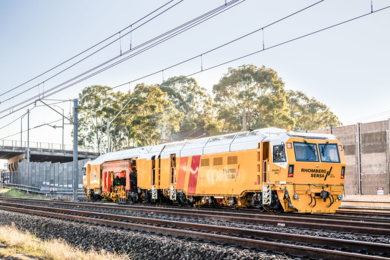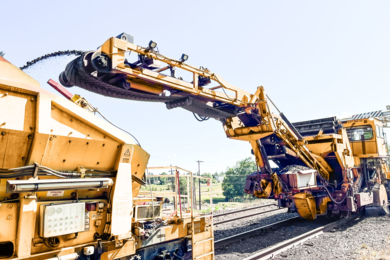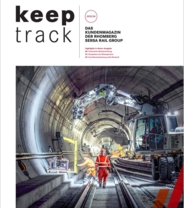system7 Regulator purchased by Irish Rail
Iarnród Éireann - Irish Rail have purchased the first ever system7 regulator to work on the Irish network. Officially unveiled earlier this year at the Transport Research Arena (TRA) conference in Dublin, Ireland, the new regulator is one of several new On Track Machines (OTMs) which Irish Rail has invested in, and which will be operated by Rhomberg Sersa Rail Group (Ireland).
The regulator is a crucial machine for preventative track maintenance. Ballast regulators create a ballast profile designed to deliver stability for the required track position. This ensures that the track remains stable under load and during thermal (rail) expansion.
The new regulator – which will be known as 705 – will replace one of the existing two regulators which are over 30 years old and are nearing the end of their working life.
Irish Rail’s Human Factors team, led by Nora Balfe, worked closely with RSRG Operators and system7 to make the machine operator focused and to ensure enhanced ergonomics.
“The machine is easier to use thanks to collaboration between system7 and Nora’s team,” said Darryl Gwilliam, Continuous Improvement and Digitisation Manager with Rhomberg Sersa in Ireland.
“It is very operator focused and very comfortable. It’s a smart machine that is environmentally friendly, efficient and will deliver the highest quality of work.”
One major difference between the new regulator and older machines is the unique LiDAR laser scanning systems – also known as profile scanners - at both the front and the back of the machine.
While there are a set number of ballast profile designs which can be input into the machine to achieve, the front profile scanner will measure and compare the as-is profile data against the required design. This measured data is displayed to allow either the machine in fully automatic mode or the operator to distribute the ballast to achieve the required profile.
This means that if there is too much ballast in one area, the regulator can autonomously move the ballast to an area where there is not enough. This work is then scanned by the laser on the rear to ensure it has been completed correctly.
This work can be carried out automatically, but if the work is being carried out by an operator, there is an array of very sophisticated cameras around the machine to give a total and clear view of the track / machine and the task being carried out.
It can then produce a ballast profile report for quality assurance or to add value to the digital suite of information about the network. This will ensure that the quality of work is measured and maintained as well as ensuring accurate ballast profile analysis can be monitored to better understand the behaviour of the track asset.
Maintenance on the new regulator will also be easier as there is a digital machine diagnostic interface which shows all the vital working functions. Sensors monitor and record key information such as temperature and pressure and sends alerts if there is an anomaly. It is expected this will allow for better planning when it comes to preventative maintenance and therefore less downtime.
The cab is pressurised to prevent any dust entering and this is just one small part of the improved working environments this machine offers. The others include a water suppression system to dampen the ballast before brushing, cabin filtration systems and as mentioned, a sophisticated camera system which will remove any requirement for an operator to work outside during ballast distribution.
Another major improvement is the ability to change the brushes in just 10 minutes.
“This is a game changer,” said Darryl. “The brushes sweep the excess ballast of the sleepers and different brushes are needed depending on the sleeper types. To change the brushes on the current old machines, the machine is required to transit back to the depot and be changed manually. But on the s7 regulator it can be done automatically in just ten minutes. It is a single person operation and avoids any down time and significantly reduces the risk of injury.”
The machine is currently going through final checks and adjustments at the s7 plant in Austria before being shipped to InnoTrans 2024 in Berlin. Afterwards it will be sent to Ireland to undergo the commissioning process before being put to work on the Irish network.








